If you want to double the battery life of your Sony a7 III, a7R III, or a9 and at the same time improve the ergonomics, then the Sony VG-C3EM battery grip will be one of the options that you might want to consider.
I’ve owned this battery grip for a couple of months now, using it mainly whilst shooting wildlife, aviation and a little motorsport.
My review aims to give you a better understanding of the grip and hopefully help you to determine whether or not it’s worth adding to your collection of Alpha gear.
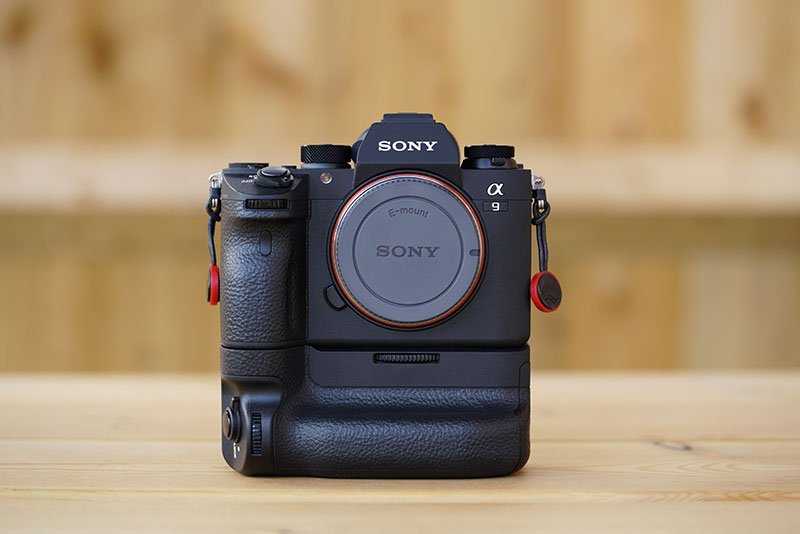
Quick Specs
- Dimensions (W x H x D): 126.9 x 107.9 x 61.8 mm
- Weight: 272g
- Batteries Supported: 2 x NP-FZ100*
- Cameras Supported: Sony a7 III, a7R III, a9
- Full Specs: Visit Sony’s Website
Who’s it For?
The Sony VG-C3EM battery grip is for anyone who wishes to double the battery life of their a7 III, a7R III, or a9 cameras and at the same time improve the ergonomics of the camera by making the grip larger and giving you somewhere to place your pinky finger. The additional controls also help to make shooting in the vertical orientation a lot more comfortable.
Because the a7III, a7R III, and a9 all share very similar bodies, the VG-C3EM grip is supported on all three cameras. I’m fortunate to own all three and can confirm that the grip fits and works perfectly with all of them. Here it is mounted to each camera.
Build Quality
The grip is made from the same magnesium alloy that can be found in all three camera bodies that it supports. This makes it extremely strong yet lightweight at the same time, it weighs in at only 272g.
Both the pattern and texture of the grip material matches perfectly with the camera bodies, if you didn’t know this was a grip extension you could quite easily believe that it was one single camera body. The buttons, control wheels, and joystick also feel identical to those found on the camera bodies.
Here’s a close-up comparison of the material on the a9 and the VG-C3EM grip itself.
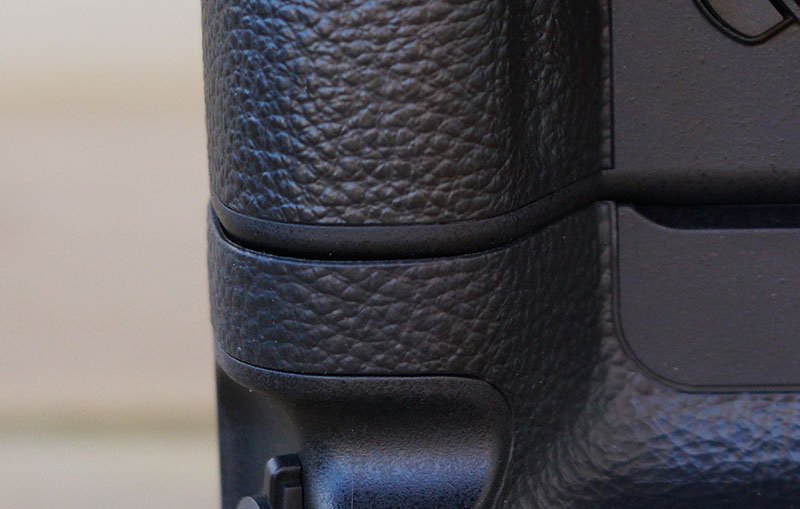
The grip is also sealed against dust and moisture, that said I wouldn’t recommend putting it down in a puddle, since we know that weather resistance is not Sony’s strong point.
Here you can see the rubber seal that should help to prevent dust and moisture getting into your camera.

However, it’s not all praise I’m afraid, the battery tray that houses two NP-FZ100 batteries feels less well built and quite fragile. Thankfully this is tucked away inside of the grip, so should hopefully come to no harm. But what may come to harm is the release catch for the battery tray, as this is rather delicate and I can see it snapping off at some point.
The VG-C3EM battery tray.

Finally, although the grip attaches firmly to the camera body, there is the smallest of gaps visible between grip and body, so it’s not quite a seamless fit. This gap could potentially allow water to get inside, but there is a rubber gasket around the base of the column that should hopefully prevent this. The gap is so small that you will only ever notice it with a light source behind, and only if you are specifically looking for it.
The tiny gap between the grip and camera body.
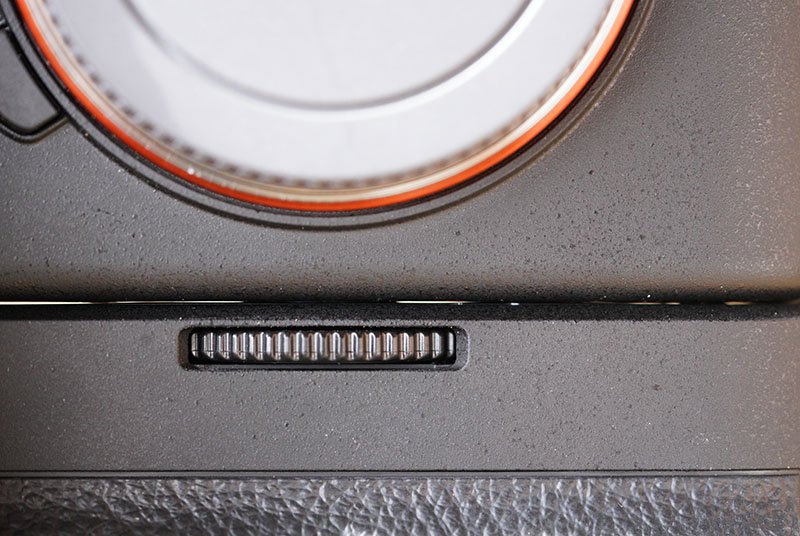
Features
The battery grip lets you make use of two NP-FZ100 batteries that are stored inside the grip itself, effectively doubling the battery life of your camera. Since the grip is inserted into the battery compartment of your camera, you will not be able to make use of a third battery here. The grip also adds additional controls and supports charging of both batteries via your camera’s USB port. On the base of the grip you’ll find a tripod mounting socket just like on the base of your camera and an attachment point for a strap.
The grip supports two NP-FZ100 batteries.
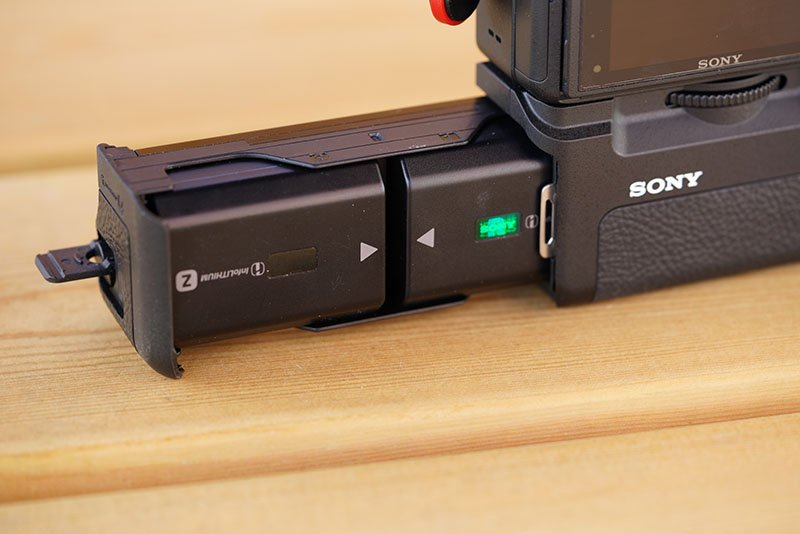
With the grip attached you can check the LCD monitor or EVF on your camera to view the remaining power of each battery. When one battery runs out, the second battery takes over. The grip will still work with only one battery inserted.
You can easily view the status of each battery.

Additional Controls
The grip design makes it very easy to control the camera in both vertical and horizontal positions, this is because the grip buttons and control dials are almost identical to the ones that you will find on the body of your camera.
When shooting vertically you’ll find: a shutter button, control rings for aperture and shutter speed, two custom buttons (C1, C2), as well as AF-On and AEL buttons, there’s also the joystick to move the AF point around. The tactile feedback and feel of the buttons is practically identical to the ones on the cameras themselves.
Here you can see the rear controls when shooting vertically.

Here you can see the top controls when shooting vertically.
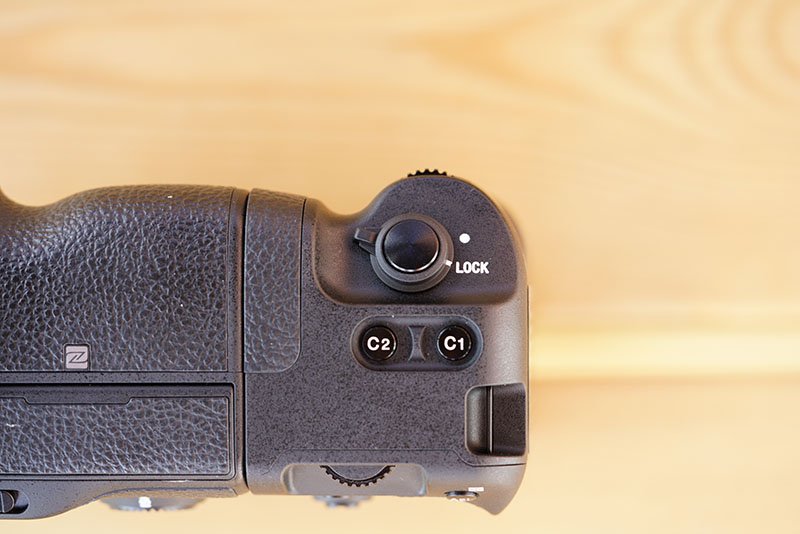
Finally, there is a lock switch which surrounds the shutter button, this is to prevent you from accidentally pressing the shutter with your palm whilst shooting horizontally, or simply just holding the camera. When shooting sports, I’ll often switch between horizontal and vertical, so tend not to make use of the lock switch, as I result it is quite easy to accidentally trigger the vertical shutter button with my palm. This isn’t so bad if you are shooting single shots, but if you are shooting in continuous on the a9, you can soon end up with a lot of wasted space on your memory cards.
Charging
You can still charge both batteries whilst they are loaded in the vertical grip simply by using the camera’s USB port, there is no need to detach the grip from the camera body. However, charging two Sony NP-FZ100 batteries via USB will take around 9-10 hours, this is almost double the time it would take if you were using Sony’s BC-QZ1 charger*. Personally I prefer to just take the batteries out and use the Sony charger, there is also less risk of surge damage to your camera this way, unless you are charging using a powerbank.
Attachment and Handling
In order to attach the grip to your camera body you’ll need to remove the battery door, a very easy task thanks to the little release catch on the inside of the door, just pull it back and the door will pop out of its fixings. My concern here was that I was probably going to lose the door, luckily Sony has thought about this and you can safely store the door inside of the grips column that slots inside your cameras’ battery compartment.
Attaching the vertical grip to the camera body.
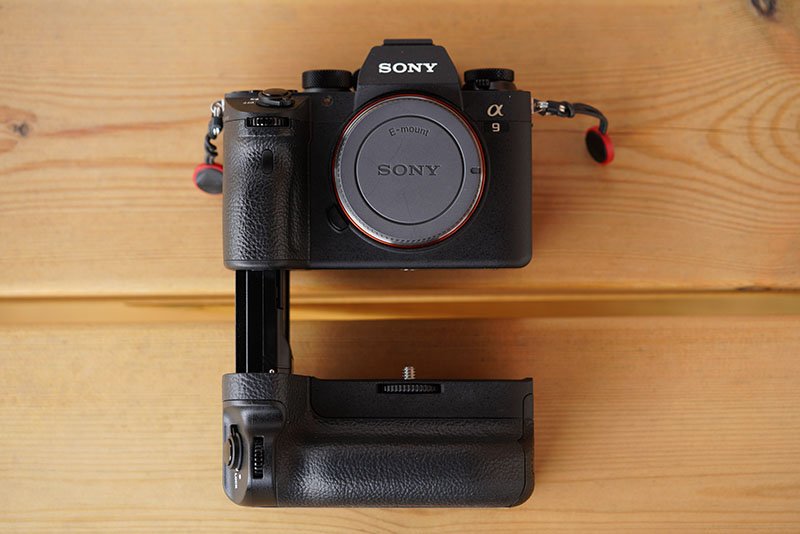
You can safely store your battery door within the grips column.

Once you have safely stored the battery door, you simply insert the column of the grip inside your cameras’ battery compartment and tighten the large fastening wheel. It’s a very good and secure fit, you don’t need to worry for a second about it coming loose.
The attachment screw/dial of the VG-C3EM vertical grip.

The grip is very comfortable when shooting in vertical mode and there is plenty of space for your fingers. When shooting in horizontal mode you will probably also find the additional grip for your pinky finger quite useful. Needless to say adding the grip and an additional NP-FZ100 battery will make your camera heavier, but this helps to balance larger and heavier lenses like the Sony FE 100-400mm 4.5-5.6 GM (my review), or the FE 70-200 2.8 GM, and of course this is probably a must have accessory for the upcoming FE 400mm 2.8 GM monster lens.
Compared To
There are only a couple of third party grips on the market right now, the most popular one is the Meike Mk-A9 Pro grip (my review). I’m working on a detailed comparison of the Meike Mk-A9 Pro and Sony VG-C3EM battery grips, so I’m not going to go into all of the details here.
But to briefly summarize: The Meike Mk-A9 Pro grip is very similar to the Sony VG-C3EM but costs around $180 less. The build quality isn’t on par with the Sony, and the buttons feel a little softer, but it does do the job that it was designed for. The Meike grip also has the added bonus of coming with a remote control that lets you remotely control your camera from up to 100 meters away with a 2.4Ghz wireless transmission. You can also use it to control the shutter in bulb mode or set an interval (time-lapse) recording.

If consistency is important to you and you’d like the battery grip to match your cameras’ body seamlessly in both looks and feel, then you will probably want to go with the Sony grip. If consistency isn’t so much of an issue, then the Meike is definitely worth a look.
If you don’t need the extra battery life or the extra vertical shooting controls, but would like a larger grip and somewhere to place your pinky finger, then you’ll be pleased to know that there are much cheaper alternatives to the VG-C3EM. My recommendation would be the SmallRig L Bracket (my review). As well as the Arca-Swiss compatible mounts it also offers additional grip height and somewhere to place your pinky finger, best of all it only costs around $59. Of course there is also the RRS L Bracket, but this costs around $200.
There’s also the Sony GP-X1EM * grip extension, but this blocks access to the battery compartment and is extremely expensive for what it is. The Meike MK-X1EM * is a cheaper alternative to the Sony GP-X1EM, but again the grip needs to be removed to access the battery compartment.
Conclusion
The new NP-FZ100 battery already dramatically improves the battery life of the a7III, a7R III and a9, so much so that I don’t think that extending it further is going to be very important to so many Alpha Shooters, unless you shoot a lot of video. So although one of the prime benefits of the VG-C3EM vertical grip is the doubling of your battery life, it’s hard to recommend it for this reason alone.
The second benefit of the grip is the improved ergonomics and somewhere to place your pinky finger. However, as mentioned in the ‘compared to‘ section above, if this is all you would like to do, then there are much cheaper alternatives.
Finally the third benefit and the one which is probably most likely to persuade you to purchase this grip, are the vertical controls. If you switch a lot between horizontal and vertical shots, or shoot a lot of vertical shots, then this grip makes shooting in this position so much more comfortable. It also helps to balance larger and heavier lenses, so will most likely be favored by sports and wildlife shooters.
Since I purchased this grip it has rarely left my camera, in fact I don’t know why it took me so long to pick one up in the first place! Sure the grip isn’t perfect, the quality of the battery tray could be much better and a more seamless fit between grip and camera body I know would be appreciated by many. But overall it’s a very nice and well-designed battery grip that compliments the a7III, a7R III and a9 perfectly.
However, what isn’t so nice is the price tag. It costs around $300 in the US and £330 in the UK, which makes it a very expensive accessory indeed! Personally I think a price of around $200 / £200 would be more reasonable, but we know that Sony does not do cheap! 🙂
Pros
- Doubles your battery life
- Improved ergonomics
- Shooting vertically is a lot more comfortable
- The design of the grip and material matches the camera bodies perfectly
Cons
- Price
- Battery tray and latch feel cheap and fragile
- It’s easy to accidentally press the shutter button with the palm of your hand when shooting horizontally, the lock switch helps but isn’t really practical if switching between horizontal and vertical positions a lot
- Very small gap between the grip and camera body


Just an FYI, I bought my Sony VG-C3EM from MPB, like new in box for under $ 100USD. Makes the decision a lot easier….
My Grip died on the wedding, Sony is rubish company, I used grip for only ten weddings 🙁
That’s frustrating Boris. Is it out of warranty?
Hi. Is it normal that my A7Riii doesn’t show the battery percentage of both batteries (only show percentage of 1 battery) when using the grip?
Which grip are you referring to? The Sony one should show both batteries, it’s odd if it only shows one. Are they both original Sony batteries? Third-party batteries don’t always show the percentage remaining.
Hey Timothy, I am looking to buy a spare battery tray for the Sony VG-C3EM grip. Do you know if the battery tray is sold separately anywhere? I want to keep a spare tray loaded with two fresh batteries for a rapid swap when the first tray of batteries dies.
Good question. I just checked my battery tray but it doesn’t even have a part number on it to search for. I can’t find a replacement on EET Europarts who are Sony’s approved spare parts supplier here in the UK. I’d recommend asking your local Sony support team. It would be strange if there is no option to buy this separately, especially as it’s rather fragile and could easily be broken, replacing the whole grip would be insane! You must be shooting a ton, I’ve not yet managed to get through two full batteries in one day!
Interesting read thanks for sharing all the info am just about to purchase my first Sony A7 series camera and coming from Nikon I have always used a battery grip as I just prefer to have one when shooting portraits.
Hope it helped with your decision Tommy. It definitely makes the a7 so much more comfortable to use in the vertical position. Enjoy shooting with the a7, it’s a great camera!